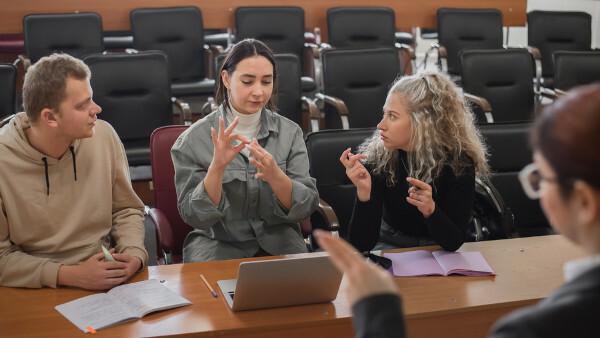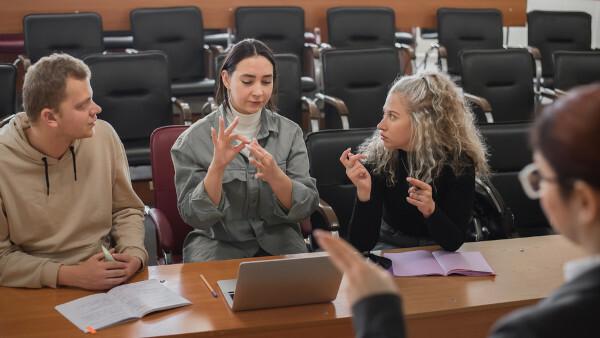O ableism is prejudice or discrimination against people with disabilities. The practice of ableism presents itself in the form of infantilization, treating as incapable people who have a disability and create physical barriers that prevent them from carrying out some activity in a independent; as well as the lack of accessibility and vacancies in the job market and education.
Ableism can be avoided by removing the attitudinal barriers that people without disabilities often place in the path of people with disabilities. These barriers are prejudiced behaviors that prevent coexistence, access to environments and acceptance of people with disabilities in society. As a result, many people consider a person to be incapable just because they have a disability.
Capacitism is associated with bodynormavativity, that is, the assumption that there is an ideal body standard, and that escaping this standard makes a person less capable of social activities. Through education and political programs, we can normalize bodies that fall outside physical, functional, and cognitive standards.
Read too: Ageism — prejudice against people because of their age
What is ableism?
Ableism is a term that describes discrimination and prejudice aimed at people with disabilities. This form of discrimination is based on the mistaken belief that people with disabilities are inferior or less capable than those without disabilities.
Second the stereotype In common sense, people with disabilities have limited or reduced capabilities, making them automatically “less capable” than people without disabilities. Hence the use of the expression “ableism” to designate this type of prejudice.
However, the problem is the conception of disability that is at the origin of the ableist reading. Is hasty generalization that results in physical and social barriers, lack of accessibility and many other forms of exclusion.
Types of ableism
Often, ableism is subtle and subliminal type, triggered by the repetition of common sense that immediately links the image of a person with a disability to one of the variations of socially constructed stigmas, to which we are accustomed and, therefore, tend not to be perceived and questioned.
In other cases, when ableism It's obvious and visible, it shows how much this prejudice is still naturalized as if it were acceptable or inevitable. The recurrence of these experiences is frequent, in varying degrees, creating barriers in the lives of different people with disabilities, as we can see in the examples below.
Examples of ableism
- Architectural and physical barriers. The lack of accessibility is naturalized in many public places, such as buildings and public transport that are not accessible to people with disabilities. This places significant barriers to their participation in society, which could be addressed with accessible ramps or elevators.
- Communication barriers. They are obstacles to accessing information. It is necessary to enable audio description of images, films and public and private events.
- Methodological barriers. There is little study and investment in adapting methods and techniques for access by people with disabilities to education, culture and leisure.
- Programmatic barriers. Ableism is reflected in the absence of public policies, legislation and standards that take into account the interests of people with disabilities.
- Attitudinal barriers. These barriers are represented by prejudices, stereotypes, stigmas and discrimination echoed in society's behavior in relation to people with disabilities.
Examples of ableist expressions and sentences
Language used in everyday life, in the media and in social communication can often be offensive or disrespectful towards people with disabilities. This includes the use of pejorative terms or the reinforcement of stigmas. Check out the examples below and, above all, try to reflect on them.
“He is mentally retarded.”
“She’s acting like she’s crazy.”
“This is so stupid!”
“Are you too stupid to understand this?”
“This task is so simple that even a cripple could do it.”
“He’s autistic, so he must be a genius at math.”
“I felt like a blind man groping in the dark.”
“She's deaf, so she can't contribute to the conversation.”
“This idea is completely insane.”

Consequences of ableism
Capacitism has the consequence of reinforcement of a social mechanism that seeks to include, but not integrate, people with disabilities in society. These people are included with reference to a set of cultural values that define, a priori, what a “normal” individual is. It is these cultural values established in society that allow us to identify which people will be stigmatized as “different”, “abnormal”, “crazy” or “disabled”.
Conversely, ableism makes it seem like the problem lies with the person who carries the social stigma of disabilitya, and not in the cultural values that allow identifying which people will be stigmatized as “less capable”. According to the logic of dominant social values, ableism can be instilled in the disabled person themselves, which is an even more dramatic consequence.
A person with a disability who believes they appear less beautiful or capable may try to do anything to look or live like a “normal” person. This attempt at integration happens concretely, for example, when the disabled person uses some type of prosthesis so that they are more socially accepted. This effort, however contradictory it may seem, ends up perpetuating the logic of exclusion that marginalizes those who are “different”.
Read too: Which groups make up the so-called social minorities?
How to avoid ableism?
To avoid ableism, First of all, we must invest in accessibility, with adaptation of urban spaces and equipment. It is also necessary to inspect and fine companies that are not complying with the law, expand jobs and hire professionals in schools with specialized knowledge to deal with the various deficiencies. These measures can be taken through public policies or public-private partnerships.
We would like to emphasize that school is an important social environment for developing social skills. For this reason, separating special needs children into schools just for them is a step backwards. O necessary is to have qualified professionals in common schools, with adequate knowledge to better care for and guide students who need special education.
If we want to combat ableism, then we need to operate a transformation in the conception of disability which is at its origin. In other words, people with disabilities should be defined by who they are, not by what they don't have. To avoid this conception of disability as something that someone lacks, it is necessary to educate people to live with differences.
In this sense, we can teach and talk more about attitudinal accessibility. This concept refers to the mental disposition and behavior of people in relation to the inclusion of individuals with disabilities in society. It involves the way people think, perceive and interact with those who have disabilities, as well as the degree of openness and acceptance they demonstrate towards differences.
Attitudinal accessibility helps us overcome prejudices, stereotypes and other obstacles that people with disabilities face often face, but which remain invisible because they are not experienced by those who do not present any deficiency. In this way, instead of building attitudinal barriers, we avoid prejudiced behaviors that prevent coexistence, access to environments and acceptance of people with disabilities in society.

Capacitism in Brazil
In Brazil, ableism manifests itself through physical barriers that prevent people from carrying out some activity independently, as well as the lack of accessibility to education and jobs in the job market for people with disabilities. This is what the data collected in the “People with Disabilities” module of the 2022 National Household Sample Survey (Pnad Contínua) reveal.
In Brazil, it is estimated that 18.6 million people aged two years or older have physical, hearing, visual or intellectual disabilities, that is, 8.9% of the population within the age group researched. Regarding the difficulties investigated, the two most declared were walking or climbing steps (3.4%), followed by seeing, even when wearing glasses or contact lenses (3.1%).
According to this research, in 2022, the illiteracy rate for people with disabilities was 19.5%, while among people without disabilities, this rate was 4.1%. In the same year, only 25.6% of people with disabilities had completed at least high school, while 57.3% of people without disabilities had this level of education.
Last year, the labor force participation rate for people without disabilities was 66.4%, while among people with disabilities the rate was just 29.2%. Inequality persists even among people with higher education: in this case, the participation rate was 54.7% for people with disabilities and 84.2% for those without disabilities.
In 2022, around 55.0% of people with disabilities who worked were informally employed, while for employed people without disabilities, this percentage was 38.7%. Finally, the average real income usually received by employed people with disabilities was R$1860, while the income of employed people without disabilities was R$2690.
Is ableism a crime?
ableism is not classified as a crime in itself with specific legislation. However, ableism, when it manifests itself in a discriminatory way or violates the rights and dignity of people with disabilities, can be dealt with under the ambit of the law.
In this case, it is discrimination based on disability that becomes illegal, which unfortunately occurs in many contexts, including employment, education and access to public services.
Ableism and legislation
O Brazil has a series of laws and regulations that seek to promote equality and inclusion of people with disabilities, as well as preventing discrimination. The Federal Constitution of 1988 and the Brazilian Law on the Inclusion of Persons with Disabilities (Law no. 13.146/2015) establish principles and guidelines to guarantee the rights and equality of people with deficiency.
Sources
DINIZ, D.; BARBOSA, L.; SANTOS, W. A. Disability, human rights and justice. Sur. International Journal of Human Rights, São Paulo, v. 6, no. 11, p. 64-77, Dec. 2009.
MELLO, A. G., NUERNBERG, A.H., & BLOCK, P. (2013a) Disability Studies in Brazil: past, present and future. Annual International Disability Studies Symposium, São Paulo, Brazil, June 20, 2013.
Source: Brazil School - https://brasilescola.uol.com.br/sociologia/capacitismo.htm



